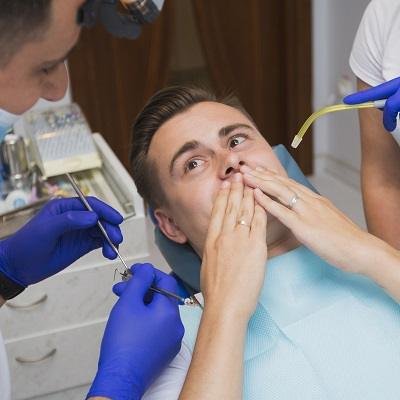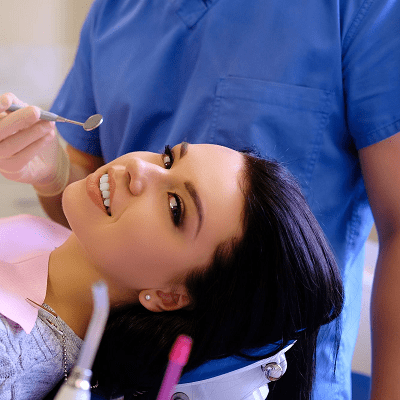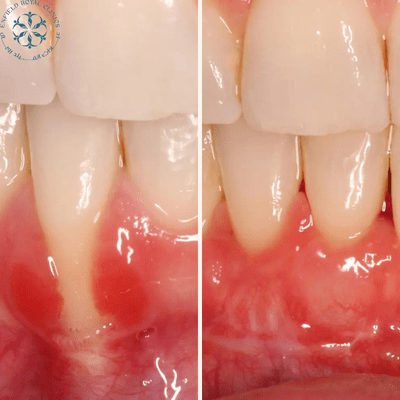
Gum recession affects millions of people worldwide, causing not only aesthetic concerns but also serious oral health complications. If you’re experiencing receded gums or exposed tooth roots, gum grafting in Islamabad offers an effective solution to restore your smile and protect your dental health. This comprehensive guide will help you understand everything about gum grafting procedures, costs, and what to expect during your treatment journey.
What is gum grafting?
Gum grafting is a specialized dental surgery in Islamabad that treats thinning gums and gum recession. During this surgical procedure, healthy gum tissue is carefully transported from your mouth to cover regions where the gum has pulled back from the tooth. This essential treatment serves multiple purposes: correcting receded gums, preventing various oral diseases, and significantly improving the aesthetics of your teeth and smile.
Benefits of Gum grafting:
Gum health improvement through grafting procedures offers numerous advantages. The treatment effectively protects exposed tooth roots from further damage and bacterial invasion. It significantly improves overall gum health while preventing additional recession from occurring.
For those seeking aesthetic smile improvement, gum grafting creates a more attractive and even gum line, enhancing your confidence when smiling or speaking. The procedure also reduces the risk of gum disease and cavities, decreases teeth sensitivity, and lessens the chances of tooth loss in the future.
Cause of Gum Recession:
Understanding the causes of gum recession is crucial for prevention and treatment planning. Periodontal disease, or severe gum disease, is one of the primary culprits behind gum recession. This condition requires professional gum disease treatment in Islamabad to prevent further progression.
Other significant factors include improper or aggressive brushing techniques that gradually wear away gum tissue. Genetics play a role too, as some individuals have a predisposition to thinning gums. Hormonal shifts, particularly during pregnancy or menopause, can affect gum health.
Certain diseases like diabetes increase infection risk and contribute to gum problems. Smoking tobacco products is particularly harmful to gum health, as is neglecting proper dental care.
When to Consider Gum Grafting
Recognizing the symptoms of gum recession early can help you seek timely treatment. Visible tooth roots are often the first sign that gum grafting may be necessary. If your gums appear painful, thin, or bleed persistently, these are clear indicators that professional treatment is needed.
Increased tooth sensitivity, especially to hot or cold temperatures, often signals exposed root surfaces that could benefit from sensitive teeth gum grafting.
Types of Gum Grafting Procedures
Your periodontist will determine the best gum grafting option based on your specific needs and the extent of recession. Understanding these different approaches can help you prepare for your treatment.
Connective tissue graft:
This is the most common method for treating receded gums solutions. The procedure involves creating a small flap on the roof of your mouth to access the underlying connective tissue. This tissue is then carefully removed and used to cover the exposed roots. This technique is highly effective and widely used in dental treatments.
Free Gingival Graft:
This approach is ideal for patients needing additional thickening of existing gums or strengthening weak gum tissue. A small piece of tissue is taken directly from the palate and affixed to the gum tissue around the affected tooth. In some cases, freeze-dried human tissue from a licensed tissue bank may be used as an alternative.
Pedicle Graft:
This technique is suitable for patients who have sufficient healthy gum tissue near the affected area. A small piece of healthy gum tissue adjacent to the exposed roots is carefully rotated over to cover them while remaining attached at one edge. This method is considered both effective and successful, with excellent healing outcomes.
Some procedures may also utilize substitute grafting material from licensed bone and tissue banks, providing additional options for patients who may not have adequate donor tissue available.
Before procedure:
Preparation of gum grafting begins with a thorough consultation with a qualified periodontist who will examine your condition and develop a personalized treatment plan. Specialist will provide specific instructions for maintaining proper dental hygiene before the procedure.
The Gum Grafting Procedure
Your comfort is prioritized throughout the procedure. Local anaesthesia is administered to completely numb the treatment area, and sedation options are often available for anxious patients. The surgical site is carefully prepared by making precise incisions and thoroughly cleaning the tooth roots.
If using your own tissue, the gum graft material is carefully harvested from the donor site. The graft is then meticulously placed over the exposed roots and secured with sutures. Some stitches dissolve naturally, while others may require removal during a follow-up visit.
The procedure typically takes about an hour for a single graft, though multiple areas may require additional time. Post-procedure care may include gargling with antibacterial mouthwash and brief monitoring to ensure initial healing is progressing well.
Maintaining Gum Grafting Results
After successful gum grafting you should maintain your oral hygiene for better and long-lasting results. Follow your periodontist’s specific instructions for brushing and flossing techniques that protect your newly grafted tissue.
Regular dental check ups and cleanings help monitor your gum health and catch any early signs of recession. A balanced diet rich in vitamins and minerals supports ongoing gum health on the one hand, and staying hydrated helps maintain an optimal oral environment for healing and long-term success.
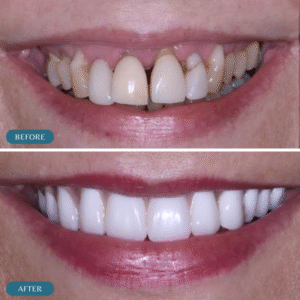
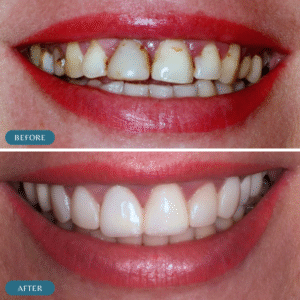
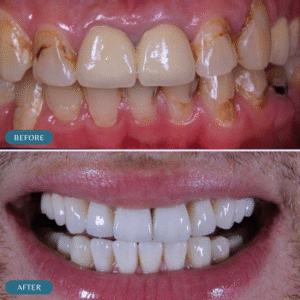
Aftercare:
Recovery from gum grafting typically takes one to two weeks, though multiple grafts may extend this timeline. Proper aftercare is essential for successful healing and optimal results.
Immediate Care (First 24-48 hours): Expect some bleeding, swelling, and discomfort during this initial period. Take all prescribed medications as directed by your surgeon. Focus on eating soft, cool foods such as yogurt, pudding, and smoothies. Use antibacterial mouthwash as prescribed, but avoid brushing or flossing directly on the grafted area. Avoid strenuous activities and resist the urge to inspect the wound or touch the area with your tongue.
First Week: Bleeding should gradually subside, though swelling and bruising may continue for 3-4 days. You can slowly incorporate more soft foods like eggs, pasta, fish, and cooked vegetables into your diet. Continue using prescribed mouthwash and gently brush teeth near the surgical site while carefully avoiding the graft itself.
Second Week: Swelling and bruising should fade significantly, and comfort levels improve. Gradually introduce more solid foods, but continue avoiding hard, crunchy, or spicy items until your surgeon gives clearance. Resume normal brushing and flossing only when approved by your healthcare provider.
Follow-up appointments are crucial for monitoring healing progress and ensuring optimal results. Avoid smoking and drinking alcohol throughout the recovery period, as these can significantly impair healing.
Cost of Gum grafting in Islamabad
The price of gum grafting in Islamabad is generally ranges around PKR 60,000 to PKR 120,000. It is more affordable compared to other major cities and countries. Understanding the pricing structure can help you plan for your treatment.
Patients can expect to pay approximately per arch for comprehensive gum grafting treatment. However, costs vary significantly based on individual needs and treatment complexity.
Factors influencing cost:
Several factors affect the final cost of your gum grafting treatment. The severity of gum tissue loss is primary – minor cases may require only a single graft, while severe recession may necessitate multiple grafts or more extensive treatment.
The type of gum grafting procedure also impacts cost. Connective tissue grafts are often more expensive due to the precision and skill required for this technique.
The facility and location of your chosen clinic affect costs as well. Premium clinics with latest equipment and technologies typically have higher charges, though this often correlates with enhanced patient experience and outcomes.
Additional treatments like deep cleaning or root planning, anaesthesia costs, prescribed medications, and other expenses all contribute to your total investment in treatment.
Why choose Dental clinic Islamabad for the Gum grafting?
Islamabad offers some of Pakistan’s most advanced dental care facilities with modern technology and highly qualified professionals. The best dental clinic in Islamabad provide comprehensive oral health services ranging from routine cleanings to complex surgical procedures, all while maintaining international standards of hygiene and patient care.
At our clinic, you can expect latest equipment, experienced dentists who stay updated with the latest techniques, and diverse treatment options compared to international standards. The best dentists in Islamabad offer personalized treatment plans, use quality materials, and provide thorough follow-up care to ensure optimal oral health outcomes for their patients.
FAQs
What should I expect during recovery?
You should expect some swelling and bleeding initially, but this typically subsides within a week. Recovery requires eating soft foods, avoiding hard or crunchy items, and following specific oral hygiene instructions. Most patients return to normal activities within 7-10 days, though complete healing takes several weeks.
Can gum recession return after grafting surgery?
While gum grafting provides long-lasting results, recession can potentially return if the underlying causes aren't addressed. Factors like aggressive tooth brushing, teeth grinding, smoking, or periodontal disease can cause new recession over time. Most patients who follow proper care instructions maintain their results for many years without additional grafting.

